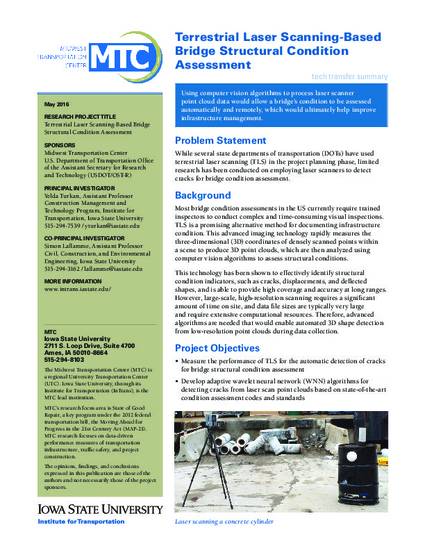
Article
Terrestrial Laser Scanning-Based Bridge Structural Condition Assessment
Tech Transfer Summaries
Document Type
Report
Publication Date
5-1-2016
Disciplines
Abstract
Objective, accurate, and fast assessment of a bridge’s structural condition is critical to the timely assessment of safety risks. Current practices for bridge condition assessment rely on visual observations and manual interpretation of reports and sketches prepared by inspectors in the field. Visual observation, manual reporting, and interpretation have several drawbacks, such as being labor intensive, subject to personal judgment and experience, and prone to error. Terrestrial laser scanners (TLS) are promising sensors for automatically identifying structural condition indicators, such as cracks, displacements, and deflected shapes, because they are able to provide high coverage and accuracy at long ranges. However, limited research has been conducted on employing laser scanners to detect cracks for bridge condition assessment, and the research has mainly focused on manual detection and measurement of cracks, displacements, or shape deflections from the laser scan point clouds. This research project proposed to measure the performance of TLS for the automatic detection of cracks for bridge structural condition assessment. Laser scanning is an advanced imaging technology that is used to rapidly measure the three-dimensional (3D) coordinates of densely scanned points within a scene. The data gathered by a laser scanner are provided in the form of point clouds, with color and intensity data often associated with each point within the cloud. Point cloud data can be analyzed using computer vision algorithms to detect cracks for the condition assessment of reinforced concrete structures. In this research project, adaptive wavelet neural network (WNN) algorithms for detecting cracks from laser scan point clouds were developed based on the state-of-the-art condition assessment codes and standards. Using the proposed method for crack detection would enable automatic and remote assessment of a bridge’s condition. This would, in turn, result in reducing the costs associated with infrastructure management and improving the overall quality of our infrastructure by enhancing maintenance operations.
Sponsors
Midwest Transportation Center; U. S. Department of Transportation
Language
English
File Format
PDF
File Size
520.70 kb
Citation Information
Yelda Turkan, Simon Laflamme and Liangyu Tan. "Terrestrial Laser Scanning-Based Bridge Structural Condition Assessment" (2016) Available at: http://works.bepress.com/simon_laflamme/34/

For this and other reports please see the InTrans project pages at http://www.intrans.iastate.edu/research/projects/detail/?projectID=1492214141 or the Midwest Transportation Center http://intrans.iastate.edu/mtc/index.cfm/research/project/project/1492214141